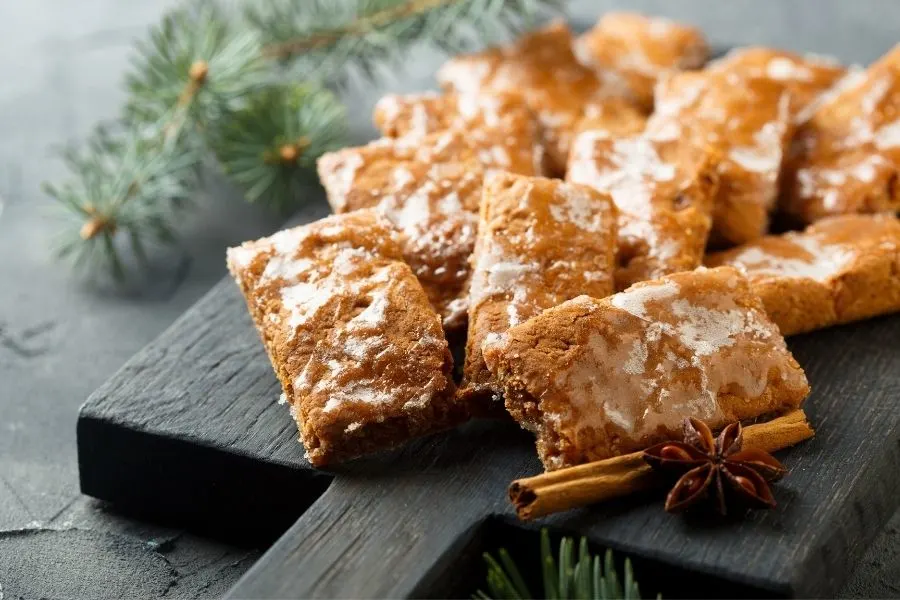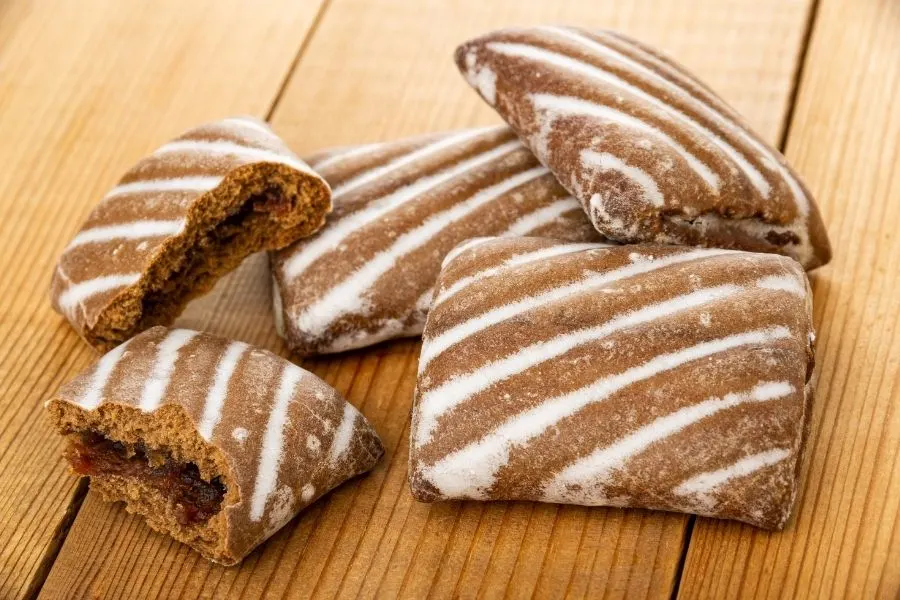Holiday season ! Cookie time, mulled wine, decorations, roast turkey and of course gingerbread ! Gingerbread is a staple of the holiday season, the same way pumpkin pie is a staple of Thanksgiving.
So of course, you want to make the best, most delicious gingerbread out there. You get the perfect recipe and you bake it and then stop to wonder if the cookies are soft enough. Or hard enough. Does it matter ? What texture should they be ?
Well, it turns out there is a recommended gingerbread texture, and we’re going to cover that in this post. Just know that, despite the recommendation, you can make your gingerbread any way you like it.

Should gingerbread be soft or hard ?
Traditionally gingerbread is supposed to be soft, a little chewy, and bend a little if you try to break it apart. This has to do with a few things, like the exact ingredients use, the amount of butter, using sugar instead of molasses, and any leavening agent you may like to add.
If your gingerbread cookies are a little hard, that’s no problem. They can be softened, and that problem can be avoided altogether by rolling the dough a little thicker, and letting them bake a little less.
Of course, the exact recipe you use will tell you from the get-go what kind of gingerbread you’ll get. Let’s talk a little about that, yes ?
Read Also:Why Is Fruitcake So Bad ?
What makes gingerbread soft or hard
Gingerbread, like any dough out there, is going to come out softer if you leave in more moisture or fat. So larger amounts of egg, butter, molasses, honey, fruit juice, milk, water are all going to contribute to a softer cookie.
Not only that, but slightly sticky, caramel-like items like molasses, actual caramel, and honey are going to make the dough chewier. Gluten also affects the chewy factor. Gluten-free gingerbread will be harder to make chewy, it will usually come out as a crispier cookie.

So take a look at two recipes for gingerbread, any two that you like. If you’re looking for a softer cookie, opt for the one with more butter, molasses, and a little less flour. But you need to remember one lest thing !
Remember to use a leavening agent
Gingerbread ca come out incredibly dense if you leave out the leavening agent. It’s usually baking soda, or whipped egg white, or self-raising flour.
If your gingerbread recipe yields a crispy cookie and you add a leavening agent, you get something similar to a cracker or shortbread with more body. You can increase the egg and flour by a little, to get a thicker, chewier cookie.
Cookies will harden a little out of the oven
Always remember that the gingerbread you bake will harden when it comes out of the oven. As in, if you bake it until dry and crispy, ti will be very brittle when it’s cooled.
If it’s just a little soft, it will continue cooking even after placing them on a cooling rack. There’s residual heat in them, and that will give another 5-10 minutes of slow cooking.
You can place tine foil like a loose tent over the cookies, this way they’ll get a softer outer texture and won’t dry out.
How to make a crispy gingerbread icing
Okay, so you’ve got a soft gingerbread cookie with a slightly crispy underside. Great, not we only need to do something about the icing. If you leave them as-is, they lose their moisture and become a bit leathery, not just soft.
So we need a good glaze to lock all of that in. The usual way is to mix icing sugar and milk, aiming for a heavy cream consistency. The thinner it is, the more the cookies will soften. The thicker it is, the crispier it will get without getting soggy cookies.
The point is to add milk (or water, or vegan milk) only to bind the icing sugar. Some folks add a teaspoon or corn syrup, and mix in some food coloring too.
This kind of gingerbread glaze is best used as an all-over pour, rather than a lining. It works as a lining too, but you have to make sure it’s thick enough or it will spread all over.
The best icing to use if you want a harder one is royal icing. It’s just Italian merengue, but with pasteurized egg whites. It get thick, fluffy, glossy, and hardens into a really beautiful layer. TheSpruceEats have a great royal icing recipe you can try out.
How to make a soft gingerbread icing
If you’re looking to keep those soft cookies soft, then you need a soft icing. This can be achieved with the icing sugar and milk recipe, only leave it a little thinner. Thicker than milk, a little thinner than yoghurt.
Of course, you can always use this as a pour-over glaze. Just be sure to use a cooling rack and a sheet pan underneath, there will be lots of pooling and dripping.
If you’re looking for other options, here’s a few ideas.
Chocolate
A thinned out chocolate glaze will work really well, and you can use any chocolate you like, be it white, dark, or milk. You will need a lot of heavy cream for this.
The more cream to chocolate you have, the thinner the glaze. This tends to work best with dark chocolate, as it hardens nicely while milk chocolate turns a little sticky, and white chocolate is a little soft.
In a double boiled heat the cream, and add some chocolate cubes, chopped as finely as you can manage. The point is to melt the chocolate, not cook it so don’t leave it on the heat too long.
Once you see the chocolate melt, turn the heat off, keep mixing, and have patience. Dark chocolate is very thick, so you will need more cream than for milk or white.
White chocolate is very thin, so you will need the least amount of cream. It’s better to make it thicker and then thin it out if you need.
Pour the thin glaze over the cookies – again, cooling rack and baking sheet underneath – let drip, and let dry. If you want to add sprinkles, do it while they’re drying.
Thinned out jam
Another option, albeit sticky, is to add get your favorite jam that you think works with gingerbread, and heat it, and thin it out a little with water.

Then brush or spoon over the gingerbread. It will dry sticky, and you can cover this with some nice chocolate glaze to give it an extra kick.
Remember that in any icing, soft or hard, you can use some extra flavoring. So something like extra cinnamon, orange zest, lemon oil, anything will work and can really help.
Read Also:Digstive Biscuits Substitute
When to use hard gingerbread
There are times when the hard, crispy gingerbread is incredibly useful. And those times are when you need to bake some really durable gingerbread house pieces.
They need to hold their shape, especially during handling by young kids, and they need to support the weight of the other pieces.
That being said, gingerbread houses are still edible, even if they’re made of a thicker, harder gingerbread. You can eat them but depending on the recipe you used they might not be that tasty, because that wasn’t the aim of the gingerbread.
If you were to use softer gingerbread for the house, you’d have some trouble and would need a whole lot of royal icing. Harder gingerbread doesn’t rise and dome like soft gingerbread, and this makes it easier to build with.
A softer gingerbread would get you a wobbly house, and a disappointment when it falls apart. So it’s best to use the two recipes separately.
Hopefully you’ve found what you were looking for today. As the holidays reach closer, it becomes more and more important to give everything a test bake and check if your dishes come out right.

